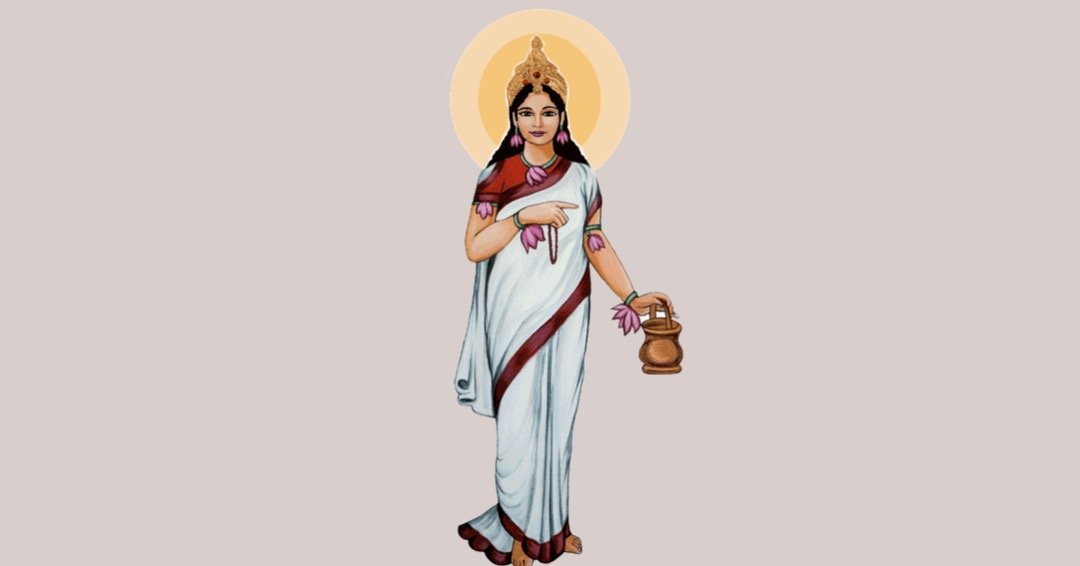Chaitra Navratri: Day 2
Maa Brahmacharini: Goddess of Penance
Chaitra Navratri is a celebration of the Goddess and all Her nine forms. The festival is celebrated in the spring, culminating in the celebration of Ram Navami, or the celebration of Lord Ram’s birth. The second day of this festival is dedicated to Maa Brahmacharini, or the “Goddess of Penance.”
Intro to Maa Brahmacharini:
The name Brahmacharini is derived from two Sanskrit words: Brahma, meaning "penance," and Charini, which refers to "her behavior" or "conduct." Together, these two terms embody the essence of a Goddess who is dedicated to the path of spiritual growth through intense penance and devotion. Brahmacharini is often portrayed as an ascetic, embodying purity, simplicity, and serenity.
Her Story:
Maa Brahmacharini, a form of Maa Parvati, devoted herself entirely to serving Lord Shiva. Every day, she visited His cave with fresh flowers and fruits, cleaning His space where He meditated. Despite her tireless efforts, Lord Shiva remained unaware of her devotion.
Meanwhile, the demon Tarakasura was terrorizing the gods. It was prophesied that only the child of Parvati and Shiva could defeat him. To ignite Lord Shiva’s love for Parvati, Kamadeva, the god of love, was sent to shoot an arrow into His heart. However, Lord Shiva, enraged by the intrusion, burned Kamadeva to ashes with His third eye.
Confused and heartbroken, Parvati vowed to win Lord Shiva’s love through intense penance. Under the guidance of Maharshi Narada, she began her ascetic practices. Starting with simple food, she eventually consumed nothing. The Shiva Mahapuran (by Veda Vyasa) describes her as “Jigaya Tapasa Munim”, the one who outshone the sages with her penance.
Lord Shiva, disguised as an ascetic, approached Parvati, attempting to discourage her by insulting Himself and questioning why she would unite with someone who wore ashes and lived among terrifying beings. Undeterred, Parvati remained resolute in her devotion, and to her astonishment, the ascetic revealed Himself as Lord Shiva. This marked the divine union of Shiva and Shakti.
Symbols of Brahmacharini: Sacred Objects of Devotion
Brahmacharini is often depicted with specific symbols that represent her commitment to ascetic practices and inner strength. Some of the most notable symbols include:
Rudraksha Beads: These sacred beads are a symbol of dedication to prayer and meditation. They serve as a constant reminder of devotion and the inner peace that comes from focused spiritual practice.
Kamandalu: This sacred water pot symbolizes the inner strength and endurance required to endure hardships on the spiritual path. It represents Brahmacharini’s ability to remain steady and focused, regardless of external challenges.
Serene Expression: Brahmacharini’s calm and composed demeanor reflects her deep inner strength and unwavering faith in the divine. Her tranquil expression invites devotees to cultivate a sense of peace and serenity within themselves, no matter the turmoil around them.
The Chakra of Creative Energy
Brahmacharini is deeply connected with the Swadhisthana Chakra, or Sacral Chakra, which governs the flow of creative energy and emotional balance in the body. The Sacral Chakra is the seat of passion, desire, and creative power, and its influence allows individuals to express their inner creativity and emotional depth. In Brahmacharini's form, this chakra plays a crucial role, as she represents the power of self-control and mastery over one's desires. By focusing on spiritual discipline, Brahmacharini encourages the practitioner to harness their creative energy in a balanced and purposeful manner.
Conclusion: Embracing Devotion and Spiritual Strength
Brahmacharini is known to provide strength, determination, and courage to her devotees. Her unwavering commitment to penance and spiritual devotion is a source of inspiration for those facing challenges in their lives. Through her worship, devotees are believed to gain the inner fortitude necessary to overcome obstacles and challenges, leading them toward self-realization and spiritual awakening.
In her seeking phase of life, Brahmacharini can also be understood as a celibate or devotee of Brahman. She exemplifies the stage of life in which an individual renounces worldly pleasures and attachments in order to fully immerse themselves in the pursuit of divine knowledge. This phase is characterized by complete detachment from material desires and a focus on spiritual fulfillment. Through this detachment, she can embody the highest form of devotion to the divine and serve as an inspiration for those who wish to follow the same path of asceticism and penance.
By meditating on her attributes, devotees can connect with her energy and unlock the creative potential within the Swadhisthana Chakra. Through devotion and penance, Brahmacharini shows that the path to spiritual growth is one of dedication, sacrifice, and inner strength. If you seek balance, strength, and spiritual growth, turning to Brahmacharini may bring you the guidance and power needed to face life's challenges with grace and wisdom.
Shloka
दधाना करपद्माभ्यामक्षमाला कमण्डलू
देवी प्रसीदतु मयि ब्रह्मचारिण्यनुत्तमा ॥
Dadhaanaa Kara-Padmaabhyaam-Akssamaalaa Kamannddaluu
Devii Prasiidatu Mayi Brahmacaarinnya[ii-A]nuttamaa ||
Maa Brahmacharini, presented by Suchismita Pahi of Sur Sangat






